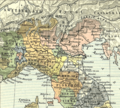War of the League of Cambrai facts for kids
Quick facts for kids War of the League of Cambrai |
|||||||
|---|---|---|---|---|---|---|---|
| Part of the Italian Wars | |||||||
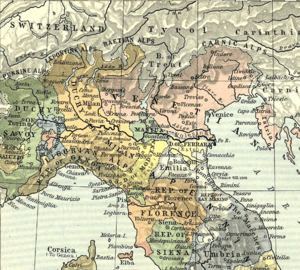 Northern Italy in 1494; by the start of the war in 1508, Louis XII had expelled the Sforza from the Duchy of Milan and added its territory to France. |
|||||||
|
|||||||
| Belligerents | |||||||
|
1508–1510: | ||||||
1510–1511:
|
1510–1511: | ||||||
| 1511–1513: |
|
||||||
1513–1516:
|
1513–1516:
|
||||||
| Commanders and leaders | |||||||
1508–1510:
|
1508–1510:
|
||||||
1510–1511:
|
1510–1511: | ||||||
1511–1513:
|
1511–1513:
|
||||||
1513–1516:
|
1513–1516:
|
||||||
The War of the League of Cambrai was a big conflict in Europe that lasted from 1508 to 1516. It was part of a longer series of wars called the Italian Wars. Many powerful countries in Europe were involved, including France, the Papal States (ruled by the Pope), and the Republic of Venice. Other important players like Spain, the Holy Roman Empire, England, and the Swiss also joined in at different times.
The war began when Maximilian I tried to march his army through Venetian land to be crowned Emperor. At the same time, Pope Julius II wanted to reduce Venice's power in northern Italy. So, he formed an alliance called the League of Cambrai. This group included the Pope, Maximilian I, Louis XII of France, and Ferdinand II of Aragon. They officially formed the League in December 1508.
At first, the League was very successful. But soon, the Pope and Louis XII started to disagree. This caused the League to break apart by 1510. Then, Pope Julius II decided to team up with Venice against France. This new alliance grew into the Holy League, which managed to push the French out of Italy in 1512. However, the allies couldn't agree on how to divide the lands they had won. Because of this, Venice left the Holy League and formed a new alliance with France.
Under the leadership of Francis I, who became the new King of France, the French and Venetians fought to get back the land they had lost. Their efforts led to a major battle called the Battle of Marignano in 1515. The war finally ended with two peace agreements: the Treaty of Noyon in August 1516 and the Treaty of Brussels in December 1516. These treaties mostly returned the map of Italy to how it looked in 1508, before the war began.
Contents
Key Events of the War
This section provides a quick look at the important events and battles during the war.
Before the War (1506–1508)
- July 1506 – March 1507: A rebellion in Genoa forced out the nobles who supported France. King Louis XII of France planned to take Genoa back.
- March 28, 1507: The Genoese rebels declared war on France.
- April 22–29, 1507: The French won the Siege of Genoa. Louis XII made the Genoese promise loyalty to him.
- April 1507: Emperor Maximilian I said Louis XII was a threat to Italy. He asked for money to lead an army into Italy.
- May 14, 1507: Louis XII left Genoa and celebrated his victory in Milan.
- June 28, 1507: Louis XII of France and Ferdinand II of Aragon met to plan an alliance against Venice.
- July 1507: Maximilian received money for his army. He decided to attack Venice because they wouldn't ally with him or let him pass through their land.
Maximilian's March into Italy (1508)
- January 24, 1508: Maximilian asked Venice for permission to march to Rome. Venice refused and got ready for war.
- February 4, 1508: Maximilian I declared himself Holy Roman Emperor in Trento.
- Early February 1508: Maximilian declared war on Venice. France sent troops to help Venice.
- February 20–21, 1508: Imperial troops invaded Venice, attacking Ampezzo and Castello di Botestagno.
- February 23, 1508: Imperial forces captured Pieve di Cadore.
- February 24, 1508: Imperial troops won a small fight at Chiusa di Venas.
- February 27, 1508: Castello di Botestagno was captured by Imperial forces.
- March 2, 1508: Venice won the Battle of Cadore against the Emperor.
- March–May 1508: Venice fought back and took over some Imperial lands, including Trieste.
- Summer 1508: Venice made a secret truce with Maximilian. This angered Louis XII of France, who then thought about joining Maximilian against Venice.
The League of Cambrai (1508–1510)
- Late November – December 10, 1508: The League of Cambrai was officially formed.
- May 14, 1509: France (part of the League) won the Battle of Agnadello against Venice.
- September 15–30, 1509: Venice won the Siege of Padua against the League of Cambrai.
- December 22, 1509: Ferrara (part of the League) won the Battle of Polesella against Venice.
- February 1510: Pope Julius II left the League of Cambrai and made peace with Venice.
- May 1510: French, Ferrarese, and Imperial troops invaded Venice.
- July 1510: The Pope and Venice formed an alliance. The League of Cambrai broke apart, leaving only France and Ferrara fighting Venice and the Pope.
The Ferrarese War (1510–1511)
- August 1510: The Pope's attack on Ferrara failed.
- August 17, 1510: Papal and Venetian troops captured Modena.
- October 1510: French troops were pushed back at Bologna.
- December 1510: Papal troops captured Concordia.
- January 2–19, 1511: The Pope won the Siege of Mirandola (1511) against Ferrara.
- May 23, 1511: French troops captured Bologna after a rebellion against the Pope.
- Late May 1511: French troops took back Mirandola.
The Holy League (1511–1514)
- October 1511: Pope Julius II created the new Holy League against France. It included the Papal States, Venice, Spain, the Holy Roman Empire, England, and the Swiss.
- February 18, 1512: France won the Sack of Brescia against Venice.
- April 11, 1512: France and Ferrara won the Battle of Ravenna (1512) against the Pope.
- May 1512: Holy League troops forced French troops out of Milan.
- June 1512 – June 1515: Spain conquered Navarre from France.
- August 10, 1512: England won the Battle of Saint-Mathieu against France.
- August–December 1512: Venice left the Holy League, and Milan joined it.
- December 29, 1512: Swiss soldiers helped Maximilian Sforza become the Duke of Milan.
- March 23, 1513: Venice and France made an alliance to divide northern Italy between them.
- June 6, 1513: Milan and Switzerland won the Battle of Novara (1513) against France.
- August 16, 1513: England and the Holy Roman Empire won the Battle of the Spurs against France.
- September 8–13, 1513: Switzerland won the Siege of Dijon against France.
- September 9, 1513: England won the Battle of Flodden against Scotland (who was allied with France). Scotland then left the war.
- October 7, 1513: Spain and the Holy Roman Empire won the Battle of La Motta (1513) against Venice (allied with France).
Francis I's First Italian War (1515–1516)
- September 13–14, 1515: France and Venice won a big victory against Switzerland and Milan at the Battle of Marignano.
- October 4, 1515: French troops captured Milan and removed Sforza from power.
- December 1515: Peace talks began.
- August 1516: The Treaty of Noyon was signed.
- December 1516: The Treaty of Brussels was signed.
Why the War Started
After an earlier conflict, the First Italian War (1494–1498), Pope Alexander VI wanted to control more of central Italy. He used French help to take over a region called the Romagna. His military leader, Cesare Borgia, was creating a strong state for his family. But then Pope Alexander died in 1503.
Even though Cesare Borgia took some money from the Pope's treasury, he couldn't control Rome. French and Spanish armies arrived, trying to influence who would be the next Pope. When Pope Julius II was elected, Cesare lost his titles. The former rulers of Romagna, who had lost their lands, asked the Republic of Venice for help. Venice agreed and took control of cities like Rimini and Faenza by the end of 1503.
Pope Julius II, now in charge, demanded that Venice return these cities. Venice was willing to say the Pope was their ruler and pay him money each year, but they refused to give up the cities themselves. So, Julius made an alliance with France and the Holy Roman Empire against Venice. This alliance didn't last long because of other political changes. However, Venice was still convinced to give up some cities, but kept Rimini, Faenza, and Cervia. Julius didn't have enough soldiers to fight Venice alone, so he spent the next two years taking back Bologna and Perugia.
In 1507, Julius again asked Venice for the cities. When they refused, he encouraged Emperor Maximilian I to attack Venice. Maximilian used his trip to Rome for his coronation as an excuse. He entered Venetian land with a large army in February 1508. He marched towards Vicenza but was defeated by a Venetian army led by Bartolomeo d'Alviano at the Battle of Cadore on March 2, 1508. Another attack by Maximilian failed even worse. Alviano not only defeated the Imperial army but also captured a lot of land, forcing Maximilian to make a truce with Venice.
The League of Cambrai Forms
In the spring of 1508, Venice angered Pope Julius by choosing their own person for an important church position in Vicenza. Because of this, the Pope called on all Christian countries to join him in fighting Venice. On December 10, 1508, leaders from the Papacy, France, the Holy Roman Empire, and Ferdinand I of Spain officially formed the League of Cambrai against Venice.
This agreement planned to completely break up Venice's territory in Italy and divide it among the allies. Maximilian would get back his lands and also receive Verona, Vicenza, Padua, and Friuli. France would take Brescia, Crema, Bergamo, and Cremona. Ferdinand would seize Otranto. The rest of the land, including Rimini and Ravenna, would go to the Papal States.
On May 9, 1509, King Louis XII of France led his army across the Adda River and quickly moved into Venetian territory. Venice had hired an army led by two cousins, Bartolomeo d'Alviano and Niccolò di Pitigliano. But they disagreed on how to stop the French. On May 14, Alviano fought the French at the Battle of Agnadello. He was outnumbered and asked his cousin for help, but Pitigliano told him to stop fighting and kept moving. Alviano ignored this and kept fighting. His army was surrounded and destroyed. Pitigliano avoided the French, but many of his soldiers left after hearing about Alviano's defeat. He had to retreat to Treviso with what was left of his army.
Venice's army had completely fallen apart. Louis took over Venetian land without much resistance. Venice lost all the territory it had gained in northern Italy over the past century. The major cities not taken by the French, like Padua, Verona, and Vicenza, were left unprotected. They quickly surrendered to Maximilian when his representatives arrived. Pope Julius, who had also banned Venice from the church, invaded Romagna and captured Ravenna with help from Alfonso d'Este, Duke of Ferrara. D'Este joined the League and took the Polesine region for himself.

However, the new Imperial rulers quickly became unpopular. In mid-July, the people of Padua, helped by Venetian soldiers, rebelled. The German soldiers guarding the city were too few to fight back, and Padua returned to Venetian control on July 17. This successful rebellion made Maximilian act. In early August, a huge Imperial army, with French and Spanish troops, marched into Veneto. Because they lacked horses and were disorganized, Maximilian's forces were slow to start the siege of Padua. This gave Pitigliano time to gather his remaining troops in the city. Even though French and Imperial cannons broke through Padua's walls, the defenders held the city. Maximilian grew impatient and ended the siege on October 1, retreating to Tyrol with most of his army.
In mid-November, Pitigliano went on the attack again, taking back Vicenza, Este, Feltre, and Belluno. An attack on Verona failed, but Pitigliano defeated a Papal army. Angelo Trevisan tried a river attack on Ferrara with Venetian ships. But the Battle of Polesella ended in another defeat for Venice when their ships were sunk by Ferrara's cannons.
With little money and few soldiers, Venice decided to send a group to Pope Julius to make peace. The Pope's demands were harsh: Venice lost its power to choose church leaders in its land, lost control over Papal subjects in Venice, had to return the cities in Romagna that started the war, and had to pay for the Pope's war costs. The Venetian leaders debated these terms for two months but finally accepted them in February 1510. However, Venice secretly decided that these terms were accepted under pressure and would be broken as soon as possible.
Even with this peace, French, Ferrarese, and Imperial armies invaded Venetian territory in May 1510. The Venetian forces retreated to Padua. By May 24, the League's armies had taken Vicenza and Polesine and were moving towards Legnago. Venice prepared Padua for an attack, but Louis, frustrated by Maximilian's absence, gave up his plans for a siege.
The Pope and Venice Team Up
Meanwhile, Pope Julius became worried about how much power France was gaining in Italy. He also had problems with Alfonso d'Este of Ferrara over a salt business and Alfonso's attacks on Venetian forces. So, Julius planned to take over the Duchy of Ferrara, which was allied with France, and add it to the Papal States.
Since his own army wasn't strong enough, the Pope hired Swiss mercenaries. He ordered them to attack the French in Milan. He also invited Venice to join him against Louis. Venice, facing new French attacks, quickly accepted the offer.
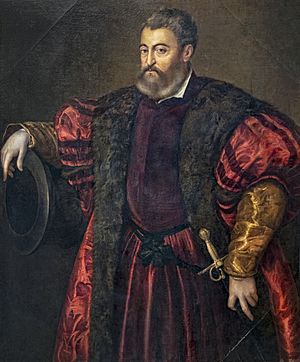
By July 1510, the new alliance between Venice and the Pope was on the attack. An early attack on French-controlled Genoa failed. But Venetian troops eventually drove the French out of Vicenza in early August. A combined force captured Modena on August 17. Pope Julius then officially removed Alfonso d'Este from the church, which he used as a reason to attack Ferrara. The Pope traveled to Bologna, expecting a quick victory.
However, the French army was not stopped by the Swiss (who had been paid by Louis to leave). The French were free to march south into Italy. In early October, Charles II d'Amboise moved towards Bologna, splitting the Papal forces. By October 18, he was very close to the city. Julius realized that the people of Bologna were against the Pope and would not fight the French. With only a small group of Venetian soldiers, he banned d'Amboise from the church. D'Amboise was convinced by the English ambassador not to attack the Pope and retreated.
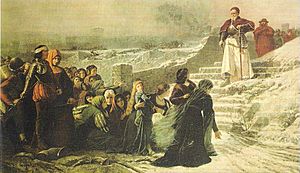
In December 1510, a new Papal army conquered Concordia and attacked the fortress of Mirandola. D'Amboise, marching to help Mirandola, became sick and died. This left the French army confused for a short time. The Pope personally led the siege, and Mirandola fell in January 1511. Meanwhile, Alfonso d'Este attacked and destroyed the Venetian forces on the Po River, leaving Bologna alone again. Julius, afraid of being trapped by the French, left Bologna for Ravenna. The Cardinal he left in charge of Bologna was not liked by the people. In May 1511, when a French army approached, the people of Bologna rebelled, forced the Cardinal out, and opened their gates to the French. Julius blamed this defeat on the Duke of Urbino, who then murdered the Cardinal.
The Holy League Against France
In October 1511, Pope Julius announced a new Holy League against France. This alliance included Spain and the Holy Roman Empire, who hoped to take land from France. Henry VIII of England also joined. He wanted to use this chance to gain more land in northern France. He made a treaty with Ferdinand of Spain in November, promising to help each other against the French.
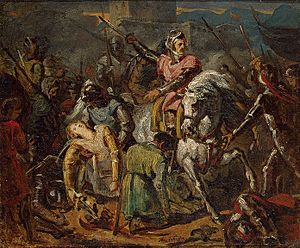
Louis XII then put his nephew, Gaston de Foix, in charge of the French army in Italy. Foix was very active. He stopped the Spanish troops from advancing on Bologna. Then he returned to Lombardy to attack Brescia, which had rebelled against the French. Knowing that many French soldiers would be needed to fight the coming English invasion, Foix and Alfonso d'Este attacked Ravenna. They hoped to force the Holy League into a big battle. The Spanish army marched to help Ravenna in early April 1512. They were badly beaten in the Battle of Ravenna on Easter Sunday. However, Foix died during the fighting. This left the French army under a new commander, who decided not to continue the fight without direct orders from Louis. He just looted Ravenna instead.
By May 1512, the French were in a much worse position. Julius had hired another Swiss army. They marched into Milan, bringing Maximilian Sforza with them. Sforza wanted to get back control of the Duchy for his family. The French soldiers left Romagna and retreated to Lombardy to stop the invasion. By August, the Swiss and Venetian armies had joined forces and forced the French out of Milan. Sforza was made Duke with their support. The French army then had to retreat back over the Alps.
In 1512, an English army led by Thomas Grey tried to take back Aquitaine in France, but they failed. Ferdinand of Aragon did not give the support he promised. The English soldiers ran out of food and money, many got sick, and the army rebelled.
In late August, the members of the Holy League met to discuss Italy and how to divide the land taken from the French. They quickly agreed about Florence, which had angered Pope Julius. At the Pope's request, the Spanish army marched into Tuscany, defeated the Florentine resistance, and put a new ruler in charge of Florence. However, they disagreed on other land divisions. Julius and Venice wanted Maximilian Sforza to keep Milan. But Emperor Maximilian and Ferdinand wanted one of their relatives to be duke. The Pope wanted to add Ferrara to the Papal States, but Ferdinand disagreed. The Emperor refused to give up any Imperial land. He signed an agreement with the Pope to completely exclude Venice from the final division. When Venice protested, Julius threatened to restart the League of Cambrai against them. In response, Venice turned to Louis XII. On March 23, 1513, France and Venice signed a treaty to divide all of northern Italy between them. Meanwhile, Pope Julius II had died in February. A new Pope, Pope Leo X, was elected.
France and Venice Join Forces
In late May 1513, a French army crossed the Alps and moved towards Milan. At the same time, Bartolomeo d'Alviano and the Venetian army marched west. Maximilian Sforza was not popular in Milan because people saw him as a puppet of his Swiss soldiers. This allowed the French to move through Lombardy easily. The French took Milan and then surrounded the remaining Swiss soldiers in Novara. On June 6, the Swiss attacked the French at the Battle of Novara. Even though the French had more soldiers, they were defeated. Some Swiss soldiers chased the French over the Alps and reached Dijon before being paid to leave.
The defeat at Novara started a period of losses for the French alliance. English troops attacked Thérouanne, defeated the French at the Battle of the Spurs, and captured Tournai. In Navarre, resistance to Ferdinand's invasion collapsed. He quickly took control of the whole region. James IV of Scotland invaded England to help Louis, but he failed to distract Henry VIII from France. James IV died, and the Scottish army was badly defeated at the Battle of Flodden on September 9, 1513. This ended Scotland's short time in the war.
Meanwhile, Alviano, suddenly without French support, retreated into Veneto. The Spanish army followed him closely. The Spanish couldn't capture Padua, but they went deep into Venetian land and could even see Venice itself. The Spanish tried to bomb the city, but it didn't work well. Since they had no boats to cross the lagoon, they turned back for Lombardy. Alviano, with new volunteers, chased the Spanish and fought them outside Vicenza on October 7. In the Battle of La Motta, the Venetian army was completely defeated. Many important noblemen were killed trying to escape. Alviano and the Spanish continued to fight in Friuli for the rest of 1513 and through 1514.
When Louis XII died on January 1, 1515, Francis I became king. He immediately wanted to reclaim his lands in Italy. By July, Francis had gathered an army. A combined Swiss and Papal force moved north from Milan to block the mountain passes. But Francis, following advice, avoided the main passes and marched through a different valley. The French surprised the Milanese cavalry, capturing a key leader. Meanwhile, Francis and the main French army met the Swiss at the Battle of Marignano on September 13. The Swiss initially gained ground. However, Francis had better cavalry and cannons. Also, Alviano arrived at the right time on September 14, leading to a big victory for Francis and the Venetians.
What Happened After the War
After winning at Marignano, Francis marched on Milan. He captured the city on October 4 and removed Sforza from power. In December, Francis met with Pope Leo. The Pope, who had been abandoned by his Swiss soldiers, gave Parma and Piacenza to Francis and Modena to the Duke of Ferrara. In return, Leo received promises that France would not interfere with his planned attack on the Duchy of Urbino. Finally, the Treaty of Noyon, signed by Francis and Charles V in August 1516, recognized France's claims to Milan and Spain's claims to Naples. This took Spain out of the war.
Maximilian tried one more time to invade Lombardy, but his army failed to reach Milan and turned back. By December 1516, he began talking with Francis. The Treaty of Brussels not only accepted France's control of Milan but also confirmed Venice's claims to the remaining Imperial lands in Lombardy (except Cremona). This effectively ended the war, returning things to how they were in 1508. However, this peace only lasted four years. The growing rivalry between the French and Spanish royal families, and the election of Charles V as Holy Roman Emperor in 1519, would soon lead to another war.
Images for kids
See also
 In Spanish: Guerra de la Liga de Cambrai para niños
In Spanish: Guerra de la Liga de Cambrai para niños


